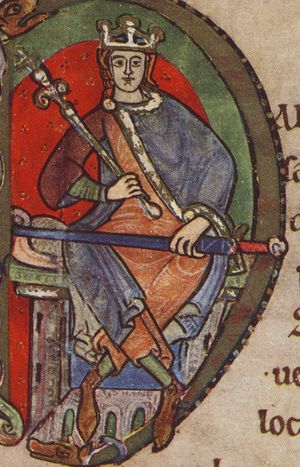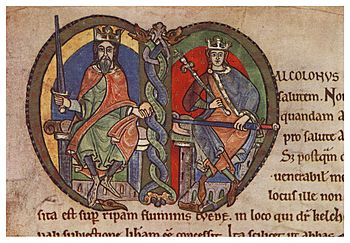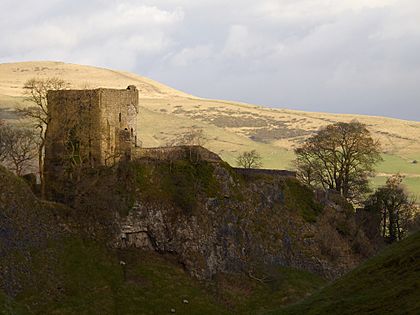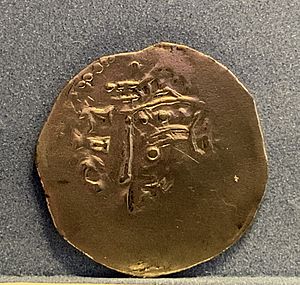Malcolm IV of Scotland facts for kids
Quick facts for kids Malcolm IV |
|
|---|---|
 |
|
| King of Scotland | |
| Reign | 24 May 1153 – 9 December 1165 |
| Coronation | 27 May 1153 |
| Predecessor | David I |
| Successor | William I |
| Born | 23 April – 24 May 1141 Scotland |
| Died | 9 December 1165 (aged 24) Jedburgh, Roxburghshire, Scotland |
| Burial | Dunfermline Abbey |
| House | Dunkeld |
| Father | Henry, Earl of Huntingdon and Northumbria |
| Mother | Ada de Warenne |
Malcolm IV (born between 23 April and 24 May 1141 – died 9 December 1165) was a King of Scotland. He ruled from 1153 until his death. People sometimes called him Virgo, which means "the Maiden." This nickname might make you think he was weak, but he was actually known for being very religious and interested in knighthood and fighting.
Malcolm was the oldest son of Henry, Earl of Huntingdon and Northumbria, and Ada de Warenne. He became king after his grandfather, David I, passed away. Malcolm enjoyed many of the same things as his grandfather, like Anglo-Norman culture. He was often sick during his rule and died at just 24 years old, without ever getting married.
Contents
Becoming King of Scotland
Malcolm's father, Earl Henry, was the son of King David I of Scotland. Earl Henry was not well for many years and sadly died on 12 June 1152. This happened in either Newcastle or Roxburgh. These areas were part of Northumbria, which King David had added to Scotland.
Unlike some kings who had no sons, King David I had three grandsons from Earl Henry. This meant there were heirs ready to take the throne. Malcolm, the oldest of these grandsons, was only eleven when he became the next in line. His grandfather, King David, sent him on a tour around the kingdom. Malcolm was joined by Donnchad, the Mormaer of Fife, and a large army. Donnchad was called rector, which might mean he was meant to rule for Malcolm if King David died.
These preparations were important because King David died less than a year later, on 24 May 1153, in Carlisle. Malcolm was made king very quickly, on 27 May 1153, at Scone. He was only twelve years old. Donnchad, who became Malcolm's regent (someone who rules for a young king), made sure Malcolm was crowned even before King David was buried. This quick action was important because Malcolm had other people who wanted to be king. Donnchad himself died a year later, in 1154.
Challenges and Neighbours
Malcolm faced several challenges when he became king. Some people thought "William the Noble," the son of William fitz Duncan, should be king. However, William was very young and never actually tried to claim the throne. He died young, and his lands went to his sisters. Another person who could have been king was Máel Coluim mac Alaxandair, an illegitimate son of Alexander I. He had been in prison, but his sons were free and tried to become king.
As a young king, Malcolm also had to deal with powerful neighbours. These included Somerled, the King of Argyll; Fergus, the Lord of Galloway; and Henry II, the King of England. Only Rognvald Kali Kolsson, the Earl of Orkney, was busy on a religious trip. But when he died in 1158, Harald Maddadsson took over in Orkney, adding another challenge for Malcolm.
The first real challenge to Malcolm's rule came in November 1153. It was from the sons of Máel Coluim mac Alaxandair. They got help from Somerled of Argyll. But this threat soon faded because Somerled had other problems. He was fighting a war with Guðrøðr Óláfsson, King of the Isles until 1156. Also, a possible fight with Gille Críst, the Mormaer of Menteith, was coming. Some people closer to the kingdom's center might have also supported Máel Coluim's sons. Two people involved in a plot were mentioned, and one died in a fight in February 1154.
In 1157, King Malcolm made peace with Máel Coluim MacHeth. Máel Coluim MacHeth was then made the Mormaer of Ross, a title his father had likely held.
Malcolm IV and Henry II of England
Malcolm was not only King of Scots but also inherited the Earldom of Northumbria. His father and grandfather had won this land during wars between Stephen and Empress Matilda. Malcolm gave Northumbria to his brother William. Malcolm kept Cumbria for himself. Cumbria, like Northumbria and the earldoms of Huntingdon and Chester, was land held from the English king.
Malcolm waited a bit to show his loyalty to Henry II of England for the lands he held in England. But he did so in 1157 at Peveril Castle in Derbyshire and later at Chester. Henry II did not let Malcolm keep Cumbria, or William keep Northumbria. Instead, Henry gave Malcolm the Earldom of Huntingdon, and Malcolm showed his loyalty for that land.
After another meeting between Malcolm and Henry in Carlisle in 1158, they were still not close friends. Malcolm was also not yet made a knight. In 1159, Malcolm went with Henry to France. He served at the siege of Toulouse, where he was finally made a knight. We don't know if this was as King of Scots or as Earl of Huntingdon. But it showed Malcolm really wanted to be a knight.
Malcolm returned from Toulouse in 1160. In Perth, he faced a rebellion from six earls. They were led by Ferchar, the Mormaer of Strathearn, and they surrounded the king. It seems Donnchad II, the Mormaer of Fife, was not part of this group. Accounts suggest the rebellion ended peacefully. After this, the king led a trip into Galloway. He defeated Fergus, Lord of Galloway, and took his son Uchtred as a hostage. Fergus then became a monk at Holyrood and died there in 1161. People used to think Fergus was part of the rebellion. But now, historians believe the earls wanted Malcolm to attack Galloway, perhaps because Fergus had been raiding their lands.
Before July 1163, Malcolm became very ill in Doncaster. He then showed his loyalty to Henry II again.
After making peace with Henry, replacing Fergus of Galloway with his sons, and settling things in Moray, only one enemy remained: Somerled. By 1160, Somerled was king of the Isles and Argyll. In 1164, Somerled led a large army from the Isles and Ireland. They attacked Glasgow and Renfrew, where Walter Fitzalan had just finished building a castle. Somerled and his son Gillebrigte were killed in battle there. The local army, led by the Bishop of Glasgow, probably Herbert of Selkirk, won the fight. People at the time believed Saint Kentigern helped them win.
Death and Legacy
Malcolm IV died on 9 December 1165 in Jedburgh. He was only twenty-four years old. His early death might have been caused by Paget's disease of bone (a bone disorder). People who lived at the same time as Malcolm thought he had qualities of a great king. Later writers were not as sure.
For example, William of Newburgh wrote very highly of Malcolm, calling him "the most Christian king of the Scots." However, not everyone thought highly of Malcolm.
It's hard to know exactly when many changes happened during this time because there aren't many records. But it seems Malcolm continued the improvements started by his grandfather. New areas with sheriffs, like Crail, Dunfermline, Edinburgh, Forfar, Lanark, and Linlithgow, seem to have started during Malcolm's rule. The important job of Justiciar of Lothian might also have begun then.
Malcolm started a Cistercian monastery at Coupar Angus. Other powerful people also started religious places, like the Premonstratensians at Soulseat in Galloway by 1161.
Fictional Stories
Malcolm IV has appeared in historical novels:
- Lord of the Isles (1983) by Nigel Tranter. This book is about Somerled, the Lord of the Isles. It tells about his military career and how he became powerful. It also shows him supporting a rebellion against Malcolm IV. The story ends with Somerled's death.
- Tapestry of the Boar (1993) by Nigel Tranter. The main character is Hugh De Swinton, a hunter at Malcolm IV's court. He first hunts wild boars that threaten people and animals. Then he helps the king's army during a fight with Fergus of Galloway. Malcolm IV eventually asks Hugh to set up Soutra Aisle, which was one of the first real hospitals in Scotland.
See also
 In Spanish: Malcolm IV de Escocia para niños
In Spanish: Malcolm IV de Escocia para niños




